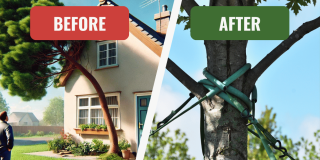One stormy evening, a client calls in panic. A majestic, 100-year-old oak tree in their backyard is splitting down the middle, threatening both their home and a neighboring garage. This tree, which has been a focal point of their property for generations, suddenly faces removal. Yet, it's more than just a tree. It's part of their family memories. Cutting it down isn't something they want to consider.
Fortunately, we arrived on the scene, assessed the damage, and offered an alternative solution—tree cabling and bracing.
What is Tree Cabling and Bracing?
Tree cabling and bracing are ways to support trees with weak or damaged branches and trunks. These methods help reduce the risk of the tree falling or breaking.
Cabling uses strong, flexible steel cables placed high up in the tree to help support branches during storms or when they get too heavy. This keeps the branches from falling but still lets them move naturally.
Bracing uses steel rods inserted into the tree to hold cracks or splits in the trunk or large branches together. This adds strength where the tree is most vulnerable and prevents further damage.
Both techniques help keep trees safe and stable, avoiding the need for removal.
Tree Cabling and Bracing Techniques
When a tree becomes weak or damaged, it might need extra support to stay strong and safe. This is where tree cabling and bracing come in. Trained arborists use these techniques to help trees grow safely and prevent branches from falling.
- Assessment: First, a professional checks the tree to see if it needs cabling, bracing, or both. They look for weak spots and assess the risk of branches falling on people or property.
- Cabling: This involves attaching strong, flexible steel cables high in the tree between weak branches. These cables reduce movement during storms and prevent the branches from splitting while allowing the tree to move slightly, which is essential for its health.
- Bracing: We recommend steel rods for severe damage, like split trunks. Unlike cabling, braces do not allow movement and are used when the tree is in danger of breaking apart.
Cabling and bracing are not permanent fixes. As the tree grows, these supports need to be checked and adjusted to ensure they continue to work effectively.
When Should a Tree Be Cabled?
There are several circumstances in which tree cabling becomes necessary. Here are a few situations when cabling and bracing might be recommended:
- Large or Overextended Limbs: Some trees naturally have long, heavy limbs that can become overextended. In cases where these limbs are at risk of snapping, cabling can help provide additional support and reduce stress on the tree.
- Weak Branch Unions: When branches grow too closely together, they can form weak unions susceptible to splitting, especially during heavy winds or storms. Cabling can strengthen these unions and prevent breakage.
- Storm Damage: Trees that have been damaged during storms may need immediate stabilization. Cabling and bracing can effectively support partially damaged trees, helping them recover and avoid further injury.
- Mature Trees: As trees age, they may develop structural weaknesses due to natural growth patterns, environmental stress, or previous damage. Cabling and bracing can help prolong the life of older trees by preventing catastrophic limb failure.
How Long Does Tree Cabling Last?
The lifespan of tree cabling largely depends on the specific conditions of the tree, the type of cabling system used, and environmental factors. On average, a tree cabling system should be inspected regularly—typically every year or after major storms—to ensure it is still effective.
Cables can last 10 to 15 years, but they may need to be adjusted or replaced sooner if the tree grows or shifts significantly. Regular inspections by a certified arborist are crucial for monitoring the system’s integrity and making necessary adjustments.
Is Tree Cabling a Good Idea?
Tree cabling is a practical and often effective solution for trees at risk of structural failure. Otherwise, it has a healthy root system and canopy. It is generally considered a good idea when the alternative would be tree removal, significantly when the tree adds significant aesthetic, environmental, or property value.
However, it’s important to note that tree cabling is not a cure-all. It will not straighten or ‘fix’ an unhealthy or severely damaged tree. Rather, it helps stabilize a tree, minimizing risk while allowing it to grow. Tree cabling is a proactive measure that can save trees, reduce safety hazards, and protect surrounding structures.
Will a Tree Straighten Itself Out?
Trees with structural problems usually don't fix themselves as they grow. If a tree is leaning or has weak branches, it will likely get worse without help. Cabling and bracing can support the tree, helping it stay stable and preventing further damage or falling.
Contact Strobert Tree Services – Expert Tree Care in Delaware, Pennsylvania, and New Jersey
At Strobert Tree Services, we provide top-notch tree care to keep your trees healthy and safe. Our certified arborists use cabling and bracing to strengthen trees and prevent damage. If a storm has damaged your tree or has weak branches, we can help protect it and your property. Contact us today for an inspection. We proudly serve Delaware, Pennsylvania, and New Jersey with expert pruning, cabling, bracing, and other services to ensure your trees stay strong for years.











